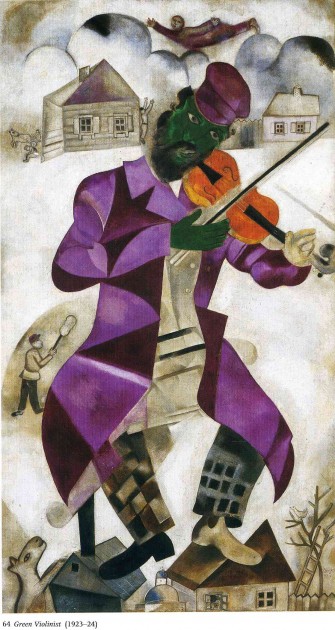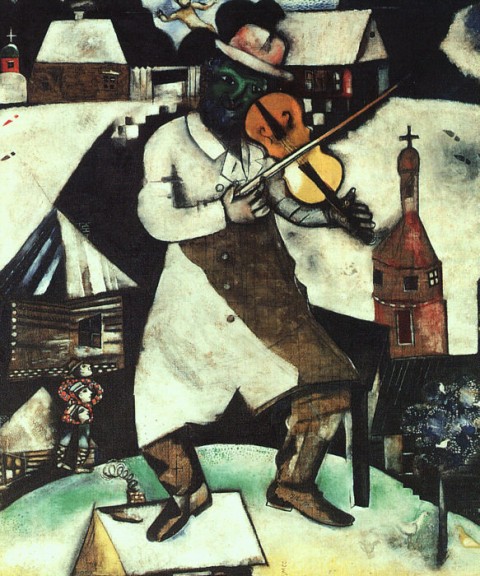Tuesday, December 11th, 2012
Chagall’s “Fiddler on the Roof”
“A fiddler on the roof. Sounds crazy, no?”
Many years ago, I got to hear the character Tevye speak those lines several times as I took part in the cast of a Fiddler on the Roof high school production. I grew up watching and participating in a lot of musicals, and I feel like I know a lot of these productions like the back of my hand. I was surprised to learn recently, though, that the musical title “Fiddler on the Roof” was inspired by Marc Chagall’s work. Even the set and original logo were done to evoke the style of Marc Chagall, who was a Russian-Jewish artist. This influence can be seen in an original Broadway windowcard designed by Tom Morrow.

Marc Chagall, "The Green Violinist," 1923-24. Oil on canvas, 78 x 42 3/4 inches (198 x 108.6 cm). Solomon R. Guggenheim Museum
The “Fiddler on the Roof” title specifically references a wall painting which Chagall created for the Moscow State Yiddish Theater in 1920. However, we can see that subject matter existed in Chagall’s imagery before this point, as evidenced by the 1912 “Fiddler” painting (the first image included above). Chagall liked the 1920 wall panel so much that he created a later copy, “The Green Violinist” (shown above).
As a displaced Russian Jew who lived in France, Chagall often turned to subject matter which evoked the cultural and religious legacy of his homeland. Jennifer Blessing writes, “The Chabad Hasidim of Chagall’s childhood believed it possible to achieve communion with God through music and dance, and the fiddler was a vital presence in ceremonies and festivals.”1 Since there is such an emphasis on “TRADITION!” and following the expectations of God in the “Fiddler on the Roof” musical, I can see how Chagall’s imagery is especially appropriate.
1 Jennifer Blessing, “The Green Violinist,” Guggenheim Collection Online. Available here: http://www.guggenheim.org/new-york/collections/collection-online/show-full/piece/?search=Marc%20Chagall&page=1&f=People&cr=4

I know absolutely nothing about art. I came across two paintings by Gian Alberti and figured the colors would go great in my bedroom. Can you point me into any direction on learning more about these paintings. I find almost nothing about him she nothing on the pieces. Thanks a bunch.
Hi TB. I am not familiar with an artist named Gian Alberti, but I found a website which mentions that Gian Alberti is a mid-20th century artist. My website is named after a Renaissance artist and theorist, Leon Battista Alberti. Sorry I can’t be of more help.
Tevyeh the Milkman was written in the late 19th century by a Yiddish writer who all European Jews grew up with – Sholem Aleichem. Marc Chagall, who was very young at the time, would have been read the story by his mum and dad at night.
So by 1912 Sholem Aleichem was still influencing Marc Chagall. Chagall, in turn, influenced the later stage production. I love the connection between literature, art and theatre!
Hi Hels! Thanks for your comment. I remember reading Sholem Aleichem’s name when I did a little research for this post, but I didn’t know much about him. Thanks for filling in some of the details. It is neat to see the connection between theater, literature, and art.
Speaking of Chagall, several years ago I remember seeing a great painting by him on the ceiling of the Paris Opera house. It was fun to watch (and listen to) a performance of “The Magic Flute” in that building, while occasionally looking up to see Chagall’s figures on the ceiling. That was a great instance where I felt like there was an interesting synthesis of music, performance, and visual art.